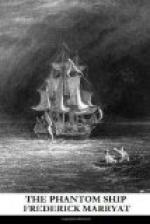Philip was right in supposing that the wind was not so strong, nor the sea so high. The vessel, after running to the southward till past Table Bay, had, by the alteration made in her course, entered into False Bay, where, to a certain degree, she was sheltered from the violence of the winds and waves. But, although the water was smoother, the waves were still more than sufficient to beat to pieces any vessel that might be driven on shore at the bottom of the bay, to which point the Ter Schilling was now running. The bay so far offered a fair chance of escape, as, instead of the rocky coast outside (against which, had the vessel run, a few seconds would have insured her destruction), there was a shelving beach of loose sand. But of this Philip could, of course, have no knowledge, for the land at the entrance of the Bay had been passed unperceived in the darkness of the night. About twenty minutes more had elapsed, when Philip observed that the whole sea around them was one continued foam. He had hardly time for conjecture before the ship struck heavily on the sands, and the remaining masts fell by the board.
The crash of the falling masts, the heavy beating of the ship on the sands, which caused many of her timbers to part, with a whole sea which swept clean over the fated vessel, checked the songs and drunken revelry of the crew. Another minute, and the vessel was swung round on her broadside to the sea, and lay on her beam ends. Philip, who was to windward, clung to the bulwark, while the intoxicated seamen floundered in the water to leeward, and attempted to gain the other side of the ship. Much to Philip’s horror, he perceived the body of Mynheer Kloots sink down in the water (which now was several feet deep on the lee side of the deck) without any apparent effort




